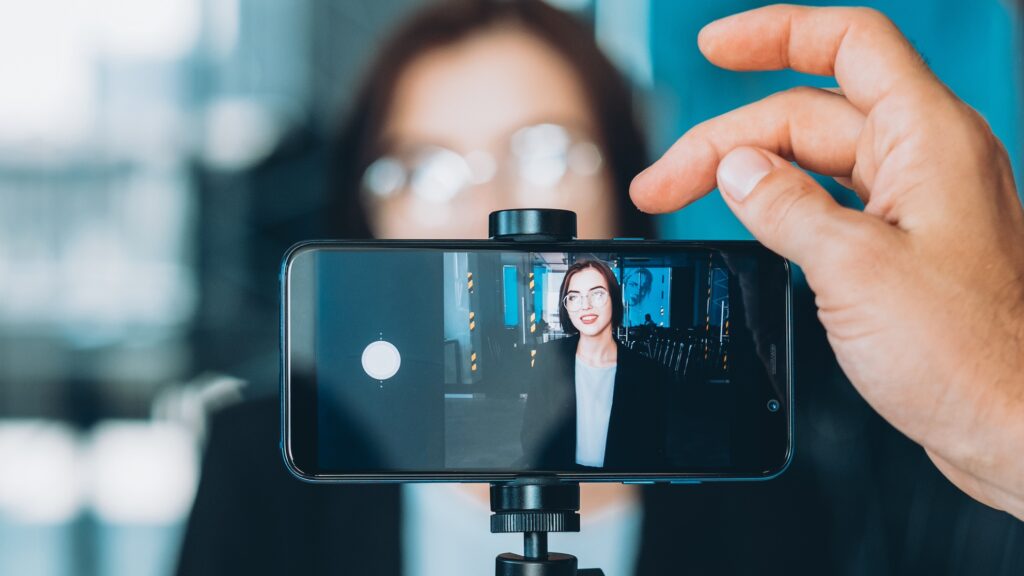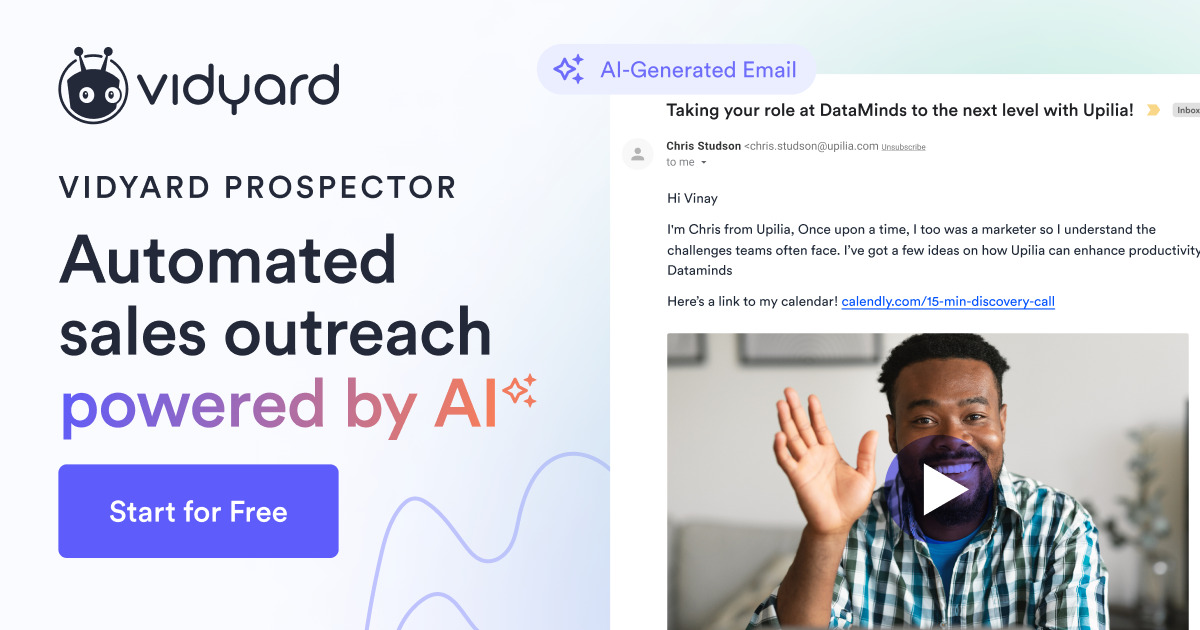The Beginner’s Guide to Remote Sales Prospecting
October 12, 2023·18 min read
Virtual selling has changed the sales world forever, so your plays need to adapt. That’s why we created a step-by-step remote sales guide to help with your prospecting strategies.
Remote sales prospecting has risen in recent years due to the ability to access more markets, save money on travel, and reach larger audiences across social media and other digital channels. Not only are sales teams across industries working remotely and choosing to stay remote, but whole organizations are. And remote sales tactics still translate well, even for those back in the office.
Digital sales cater to the type of communication buyers want and need. But when it comes to the most effective way to prospect virtually, what’s the winning remote selling playbook?
Vidyard sales reps pioneered using video for prospecting as they had the perfect tool in their back pocket for years. Because of this, our teams have developed the virtual prospecting skills needed to connect remotely meaningfully while still driving conversions. Now that many organizations have gone virtual or hybrid, the market is finally catching on, and video messaging is a practical and essential addition to any prospecting cadence.
With all the knowledge gained from this diverse landscape, we put together a super accessible and stealable remote sales and prospecting playbook to help you learn how to sell remotely more effectively.
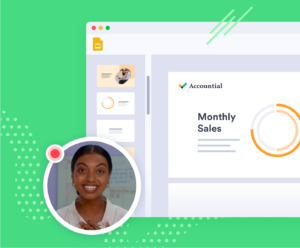
 Get more responses and book more meetings with video prospecting. Sign Up Free
Get more responses and book more meetings with video prospecting. Sign Up Free
What Is Virtual Prospecting?
Sales reps employ virtual prospecting to leverage digital tools and techniques for identifying and engaging potential customers. This approach enables B2B outbound reps to extend their reach, foster relationships, and generate leads sans face-to-face interactions.
The buying and selling process transpires via virtual platforms and communication channels during a virtual sale. These encompass video conferencing, email, online chat, video messaging, and phone calls, enabling buyer and seller interaction despite physical separation. Effective communication and adept utilization of digital tools are pivotal to virtual sales, facilitating product demonstrations, addressing inquiries, and ultimately closing the sale remotely.
The ascent of remote sales has given rise to virtual sales representatives, who share the same responsibilities as their traditional counterparts, albeit with a digital-first approach. Virtual prospecting skills are prerequisites for today’s business and sales development reps. These representatives exhibit adeptness in leveraging digital platforms and tools to engage prospects and guide them through the next phase of the buying cycle.
How to Stand Out When Virtual Prospecting
Every deal may be unique, but they begin to blur together, don’t they? It’s like watching a movie on repeat. Some patterns come into focus. Personas grow predictable. Actions congeal into a checklist. That’s why it pays to adopt remote selling best practices and sales plays that will stand out. Sellers across the board agree it’s taking more touches to reach buyers, so how do you stand out while virtually prospecting? One is having an effective omnichannel sales play is your best bet. And two is for SDRs and BDRs to brand themselves to stand out.
Building a Winning Virtual Selling Template
If you can systematize your winning outreach patterns, you raise the bar for yourself and everyone on your team. Suppose sales leadership and sales enablement provide reps with a template to work from. In that case, they can all start from the same baseline of digital prospecting techniques specialized to their team, and more seasoned representatives can take the templates and run with them. That way, everyone can innovate from a better and more streamlined baseline. Those who are busy and plan to follow whatever guidelines are provided are put in a position actually to come across as personal.
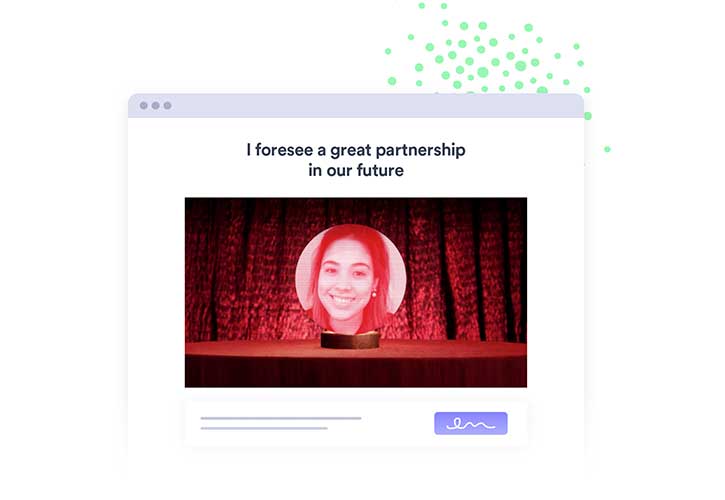
And if your team can be prescriptive by working from templates, then you can be predictive. When you build sequences from a standard mix of calls and voicemails, video messaging, and emails, you can run A/B tests to learn which works best. You gather data not just from one individual but across the team, and it’s only by standardizing things at this level that you learn valuable lessons and pave the way for each rep to brand themselves gradually.
Yes, we said brand themselves. In that same way, prospects can blur together, and so can salespeople. Buyers’ inboxes are flooded. All sensors are set to “ignore.” It’s a remote seller’s world, and it’s when someone who’s perfected their process dares to be consistently different that they stick out. The remote selling strategy for being that politely persistent but unforgettable presence? It’s all outlined below.
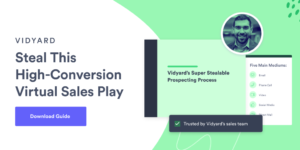
 Take this guide to go as a portable PDF. (Perfect for sharing with your team!) Download PDF
Take this guide to go as a portable PDF. (Perfect for sharing with your team!) Download PDF
Create and Embrace Your Personal Brand as a Virtual Seller
Many reps don’t realize that remote sales prospecting is primarily a game of branding. Their name, their headshot, their clothing, their background, their tone—those are opportunities to stand out. Everything that’s the same as others is something prospects will forget. Everything different is something they’ll remember. Be the pop of color in a crowded inbox.
Once they’ve been noticed, the next all-important yet elusive thing to do is deliver practical help. When reps are on autopilot sending messages, helping is difficult. Under pressure, many default to simply asking for 30 minutes of people’s time. But nobody has time to spare for no reason. To be effective at sales prospecting, salespeople must become obsessed with understanding how they can help buyers solve their problems via your product or advice and consistently seek to give more than they get.
If someone works those two things into their remote prospecting efforts—a personal brand and an obsession with helping, not selling, they will be unstoppable.
To explore your personal brand, ask yourself five questions:
- What do I offer that no one else can?
- How would close friends describe my strengths?
- How do they describe my strengths? (Ask them!)
- What can I read to know more about my prospects’ problems than they do?
- What color, tone, prop, or background can I use to appear unique?
Continue to revisit these questions until you have answers.
The 4 Components of Effective Remote Prospecting Sequences
Every memorable sequence or sales cadence is defined by its four components—targeting, the number of steps, the timing between steps, and the timing of steps. We’ll dive in on each in more detail below.
1. Targeting Prospects
Who is the sequence for? The more you know, the better; the narrower the audience, the more relevant you can make your message. There is, of course, a diminishing return—you can’t sell to an audience of one. But defining your ideal customer profile (ICP), segmenting prospects by persona or vertica, and writing messages specific to each is a great start.
When you match messages to segments, you get:
- Higher response rates: It’s more likely to be seen as authentic and not spam.
- You’ll develop better “pocket stories”: When reps work within a few well-defined segments, they memorize great stories they can repeat over and over.
- Less room for errors: When they focus on one segment at a time, they’re less likely to get tripped up and say things that don’t fit your industry.
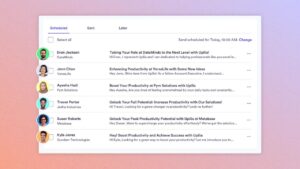
 Spend less time hunting leads and more time hitting quota with Vidyard Prospector. Learn More
Spend less time hunting leads and more time hitting quota with Vidyard Prospector. Learn More 2. Number of Steps
How many touchpoints should you have in your sequence? Invariably, the number is more than you think. While most sellers stop after three touches, it’s known that most prospects don’t respond until after at least 10. That gap is why most sales outreach success rates languish in the low single digits.
To increase the number of steps in your sequences, consider your tone. If it’s aggressive and assumes they owe you something, you may get a quick response, but it won’t be what you want. But if it’s politely persistent, you can get away with many touches, which helps familiarize them with your brand. Even if you can’t get them on the phone right away, the message and your brand as a seller will begin to sink in.
To keep your reps within the polite persistence range, teach them to ask themselves, “If this email or voicemail wound up online, how would it look?” Always assume the best in your prospect.
3. Timing Between Steps
How much time passes between each step in the sequence? Just as with the number of steps, an outreach cadence that’s too aggressive can irritate people. But too infrequent is equally bad—if you message someone twice and then pause for a month, they’re liable to forget you. The ‘personal rep branding’ clock will reset. When you reach out again, you are effectively starting over.
The best cadences begin with a flurry of five touches across a variety of channels and messaging formats and then continue at a consistent tempo.
4. Timing of Steps
What time of day do you reach out? This one’s a little trickier to perfect because, for some prospects, a Sunday night email is a blessing, while it’s a bane for others. Averaged across enough touches and accounts, however, you should be able to develop a timing rule of thumb and then customize where needed.
Some sales enablement tools save you the trouble by telling you when they’re most likely to open your email based on when they opened previous ones.
Examples of timing rules of thumb:
- Sales managers clear their email late at night and early in the morning
- Executives check email after dinner or putting kids to bed
- Developers start their day late
- Traditional industries like manufacturing tend not to be on LinkedIn
- If someone isn’t a desk worker, they’ll be a lot harder to reach by email
- Restaurateurs are challenging to get during mealtime
- Homebuyers tend to pick up on weekends
The Best Type of Outreach for Remote Prospecting
What type of outreach will you select for each touch? Some pair well together, like emails, followed by telesales. Given that you can’t know what channels your prospect prefers, creating variety, covering many bases, and monitoring what works is a good idea.
Remote Prospecting Outreach formats:
- Phone call
- Video messaging
- Social media
- Direct mail and virtual gifts
The good news is virtually everyone in the business world uses email. The bad news is that much of it is spam, and people are primed to ignore it. Your challenge is writing an email that gets past their spam trap, a subject line and body copy that passes the ‘Is this a real person?’ sniff test, and a call-to-action clear enough to inspire a response.
Remote Selling Tips for Using Email Effectively
- Ask yourself what else in their inbox is competing for their attention
- Use shorter emails if you know they’ll be reading on mobile
- Many readers tend to sort emails on mobile but return to reading on desktop
- Schedule them to send at the optimal time
- Ask how your personal brand can fit into the subject line
- Use AI prompts to help craft your messages or automated prospecting tools

 Get more responses and book more meetings with video prospecting. Sign Up Free
Get more responses and book more meetings with video prospecting. Sign Up Free Phone Calls
A phone or cold call is your most direct outreach method. Unlike softer asynchronous communication like email or video, you can have a live conversation and address misunderstandings or sales objections immediately. And, because calling can be uncomfortable, it is among the most underused tactics. Few of your competitors are doing it.
Tips for Using Cold Calls for Remote Prospecting
- Always leave a voicemail—that’s a brand touch
- Prepare a script, but then wing it—it’s better to sound like a person
- Use a headset or earbuds—higher call quality is a subtle differentiator
Video Messaging
Video helps convey a lot of information plus your personal brand in a simple, intriguing format. Few people can resist the triangular “Play” button on a video thumbnail, and just the fact that it’s video creates a high expectation of value. Lots of people get emails. Few people get an email with a video recorded just for them, especially outside the software industry.
A video message builds personal connections and trust more than any other format. When people can see and hear you, they get to know you, even if it’s only a one-way message. Plus, on video, you can be informal and candid in ways that would sound presumptive in text. Videos are typically delivered via email using a sales tool like Vidyard Video Messages but can also be sent via LinkedIn and other direct digital channels.
Tips for Using Video Messages for Remote Prospecting
- Choose the right type of sales video to record or share
- Use a dynamic video thumbnail—either an image or GIF
- Hold up something with their name to show it was recorded just for them
- Use a video prospecting template if you’re not sure what to say

 Get more responses and book more meetings with video prospecting. Sign Up Free
Get more responses and book more meetings with video prospecting. Sign Up Free Social Media
Leveraging social selling and using channels like LinkedIn can be great for delivering supplementary touches. The key is knowing that it’s a place for conversations, not pitches. Spend your time helping others, not reminding them how they’re supposed to help you. Connect directly with your prospects, and if they do accept your request, don’t start with the hard sell. And if you post more broadly, be more thoughtful than just posting links without context.
Tips for Using Social Media for Remote Prospecting
- Stay positive
- Seek to help
- Have a personality
- Stay professional
Direct Mail and Virtual Gifts
Direct mail, or sending physical letters or gifts by mail, is a dependable channel and a good way to connect online to offline. Somehow, touching things gets people to react in ways that reading online doesn’t, and people at least scan nearly everything they receive. The challenge these days is discerning whether someone’s office is still a valid place to send something, whether they’re comfortable receiving something at home, and whether the cost of the direct mailer will produce a positive return. An alternative approach that is rising in popularity is sending a virtual gift via email, such as a relevant or eye-catching gift card. Although higher-value gifts may be reserved for your account-based marketing programs, sometimes a simple handwritten note can go a long way.
Tips for Using Direct Mail and Gifts for Remote Prospecting
- Handwrite your letters
- If giving a gift, send something useful
- Be clear about who it’s from and why
- Include a clear call to action
A Step-By-Step Remote Prospecting Play for Virtual Sellers
Okay, so we’ve discussed remote cadence components and types of outreach; let’s get to the action so you can start booking more meetings. Buckle up as we explore our ideal and stealable prospecting play. It’s an exact play you can borrow and run with or easily adapt to your unique market. The more you test and adjust it, the better it’ll work for your team.
There are seven stages or days on which you conduct outreach, with one or more touches on each day.
Vidyard’s Super Stealable Virtual Prospecting Play
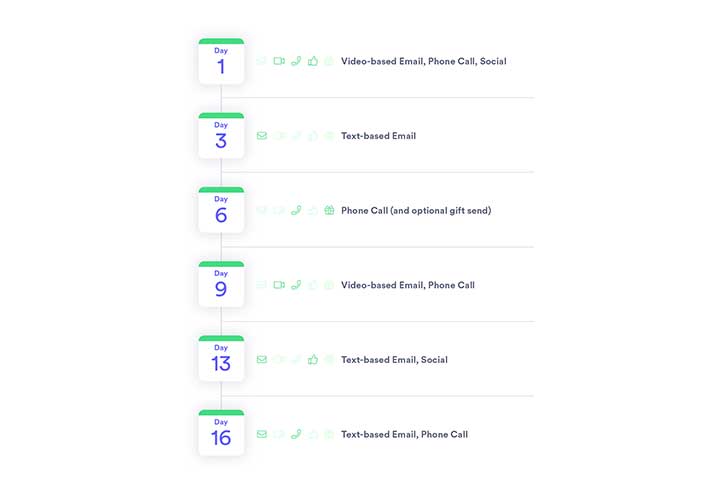
Remote Prospecting Play – Day 1
Day one begins with three touches, each on a different channel. This gives you greater coverage, and even if you don’t get through today, it makes it unmistakable that someone is trying to reach them.
Send a Video Email Message
Send a video within an email where if they click the thumbnail, it opens in a browser where they watch. First impressions are lasting impressions, and using a video both sets you apart and ensures they’ll associate all your following outreach with a face and a name.
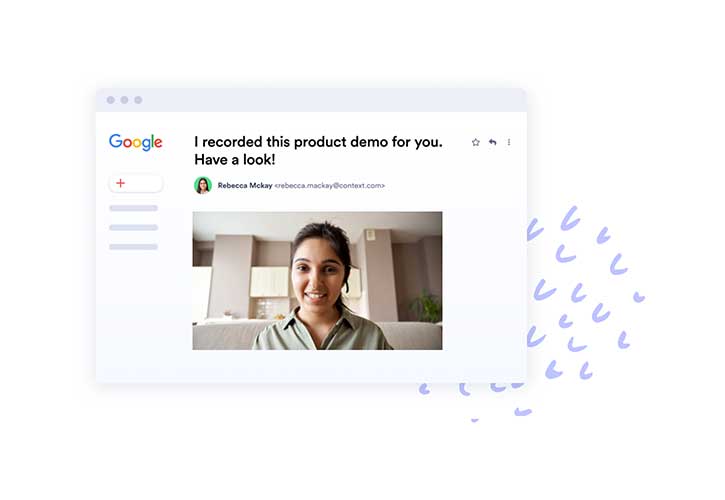
Types of Sales Prospecting Video You Can Use
Selfie or Webcam Video
A selfie or webcam video is the best way to project your personality. If there were a virtual version of knocking on someone’s door and being invited in, this would be it. You can record a selfie-style webcam video directly from your browser, desktop, or inbox using tools like Vidyard. Keep it short, direct, authentic, and full of energy.
Screen Share
Use a screen share tool to show something you want to talk through, like their website, LinkedIn profile, a diagram you’ve created, or your product. Use this opportunity to show, not tell, how you’ve done your research. Keep it under 60 seconds and end with a very clear and compelling reason they should talk to you and how to book a time.
Selfie Plus Screen Share
You can record a selfie video in the bottom corner of your screen share video—it’s the best of both worlds. Sellers agree this type of video performs the best at getting responses.
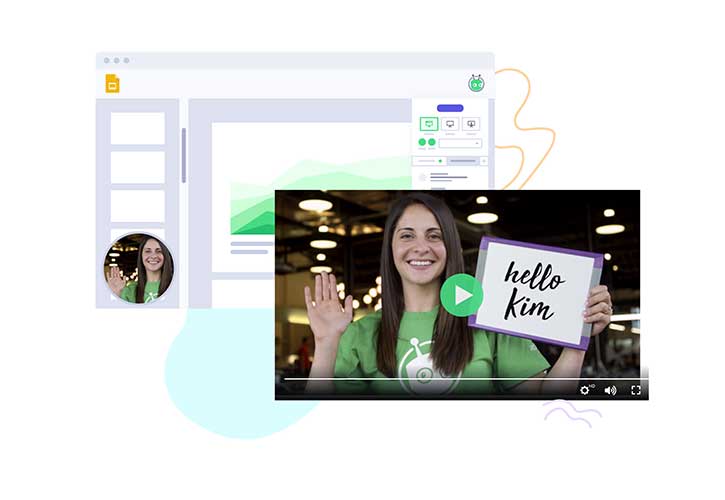
Phone Call
After your video email, wait 15 minutes to an hour and call. If you connect, introduce yourself, reference the email (if you can track your video, you may already know they’ve watched it), and get right to the point. Suggest scheduling a time to talk further—while you may have ambushed them here, you can give them time to compose themselves and talk things through without pressure. Book it with them on the phone, and if they’re interested, don’t end the call without securing that next step.
If you don’t connect, leave a voicemail that also introduces yourself, references the video email, and concludes by asking them for feedback on the video you sent. If people know you’re being politely persistent and this isn’t the last touch, they’re more likely to respond, and even if the answer is no, it’s good to hear that sooner.

 33 of the most common sales objections and how to respond to them. Get the Guide
33 of the most common sales objections and how to respond to them. Get the Guide Social Touch
Social touches can be a touchy subject. You can most effectively connect over a genuine shared interest and slowly invite them into your social circle—either by connecting via LinkedIn or commenting on their tweet. The least effective thing you can do is pitch. LinkedIn is rife with people who pitch in connection requests, and it turns people off. It’s a sure way to be blocked, even if your offer is relevant.
Remote Prospecting Play – Day 3
Plain Text Email
Reply to the email where you sent the video and keep things very short this time. The goal is to get them to watch the video. Could be as short as, “What do you think?” or “Would love your feedback on the video I made you below!”.
Remote Prospecting Play – Day 6
Phone Call
Call again—if you connected the first time, review your notes carefully, pick up where you left off, or pick up referencing the thing they said they’d go check on or the meeting they “had to run to.” Keep it natural and conversational. The goal here is to convince them to schedule a longer call, though if they want to talk through it now, which is sometimes the case, have your notes ready and go for it.
If you don’t get through, leave another voicemail again referencing the email you sent them.
Direct Mail or Virtual Gift
While you might skip or replace this step for leads who aren’t a top priority, a direct mail or virtual gift touch can be very impactful for account-based selling efforts to hit key accounts. Like a video, the handwritten letter or gift is a mark of authenticity and reminds them they’re dealing with a real person who has something important to tell them. Keep it very short, with a clear call to action.
If you have their home office address, send a handwritten letter or something similarly thoughtful—depending on the value of the account, perhaps swag or something specific to get them to attend one of your company’s events, like popcorn to enjoy while watching. Before sending, confirm that the address you have for them is correct, and tie the gift to the ask. For example, “Enjoy dinner on us while you attend this presentation.”
If you don’t have their address, you can send a virtual gift via email, such as inviting your prospect to ‘connect virtually over a coffee’ and including an electronic Starbucks gift card or an ebook.
Remote Prospecting Play – Day 9
Send Another Video Email Message
If you’ve sent this many touches and not received an out-of-office alert, it’s likely they at least know you and your company but aren’t sure what’s in it for them. Resolve that with a screen share video where you walk through some of the benefits. The more personal to their industry, role, and exact situation, the better—don’t say, “Most businesses save time.” say, “Product managers like you at companies like yours save four hours each week.”
Your tone and cadence should be such that it’s like you’re simply carrying on a conversation (that so far has been a little one-sided) and explaining further, for their benefit, with zero judgment.
Keep it short—under two minutes—and end with a friendly cliffhanger convincing them it’s worth 30 minutes of their time.
Matt Hall from Woodway UK made an unboxing video to show prospects where they’re going wrong with packaging and how he can help. To double down, he also used the Vidyard bubble feature over top of his unboxing video so that he could walk the prospect through the pitch.
Showing the prospect their own company’s product provides a compelling reason for them to click.

Remote Prospecting Play – Day 13
Plain Text Email
Same as last time, reply to your prior video message with an exceedingly short reminder to watch.
Social
Enough time has elapsed since your connection or last social touch that you can begin using that channel to direct attention to your other communications (assuming they connected). Consider recording and sending a short video in a direct LinkedIn message using Vidyard’s Chrome extension or using what LinkedIn calls a Voicemail Drop, where you can record and send a direct audio message (60-second maximum). Audio messages are unusual and can be refreshing and intriguing.
If they didn’t accept your connection, tag them in a post along with a current customer and start a conversation about something shared that they’ll likely want to talk about. Or tag them in a relevant article. As a last resort, use one of LinkedIn’s infamous InMails to send a direct message, which is like an email but even shorter.
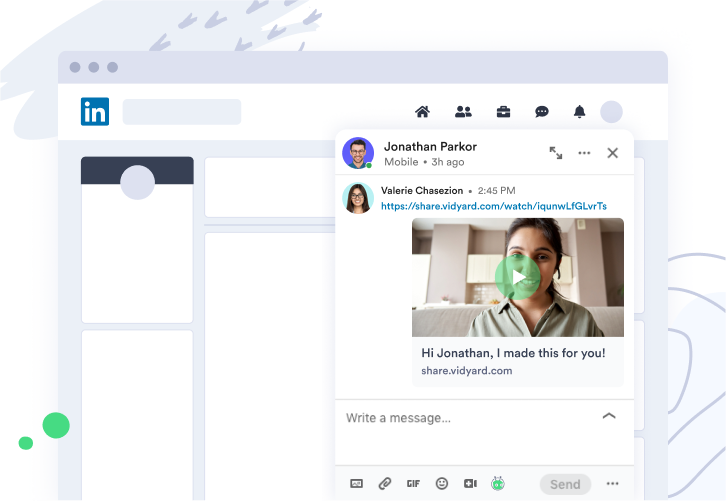
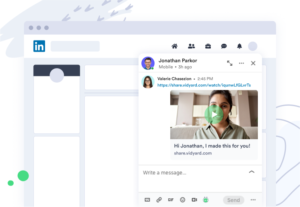
 Sign up for a free account to record and share videos on your LinkedIn page and through direct message. Sign Up Free
Sign up for a free account to record and share videos on your LinkedIn page and through direct message. Sign Up Free Remote Prospecting Play – Day 16
Plain Text Email
This is it—after today’s outreach, you’re going to put this person or account on pause. There are a million reasons why they didn’t respond, but now is your opportunity to disrupt your pattern of friendly outreach and get real. Express that you understand they may have a lot going on, but in the face of what your solution can offer and the fact that there are all these benefits, won’t they reconsider?
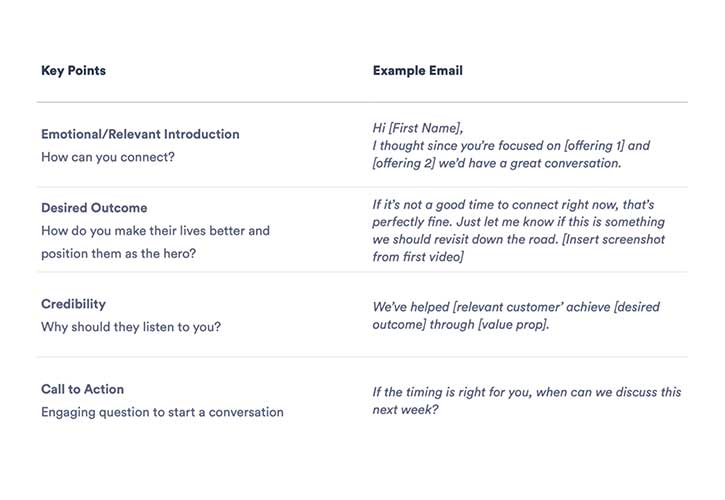
Phone Call
This is the last touch—give the email five minutes and then call on the phone. If you don’t get through, leave a voicemail letting them know to check out your email.
Remote Prospecting Messaging Strategies
Remote sellers now spend 20% of their time writing, yet few think of themselves as writers per se and exceedingly few focus on writing as a skill. Yet it’s a huge differentiator, and you can really stand out from competitors (personal brand, anyone?) by being excellent at messaging. Here are three exercises to help you work on your messaging.
Exercise 1: How to Write Effective Messaging
Ideally, you have messaging from your marketing or product teams to begin with. Adapt it to the specific needs of those you’re reaching out to. In particular, have your reps ask themselves three questions:
Would this be helpful to them even if they never purchased our product?
Buyers are busy people trying to solve problems. They also get a lot of outreach, and most of it is begging for their attention without offering something in return. List out things they want irrespective of your company. Write messages to deliver that. If you can be helpful in that way, you can build a relationship where they’re willing to hear you out.
Can I explain it in fewer than five sentences?
If not, it’s too long or too complicated. Perhaps you don’t yet understand it well enough to distill it down. Take a look at what others are sending.
Would someone not from this industry understand what I’m talking about?
Everyone is coming from a different level of understanding, and while you don’t want to state the obvious, you also don’t want to assume people know as much as you do. Write simply, and if you must introduce potentially unfamiliar terms, explain them.
Exercise 2: Hone Your Email Tone
Everything you write has a tone. Do you know what yours sounds like? Ask teammates for feedback and tailor yours to the buyer and situation.
Does it fall within an eighth-grade reading level?
As they say, simple writing isn’t dumb. Simple is clear. Some of the most famous authors write at an eighth-grade reading level, and you should, too (or less!). Otherwise, you may sound scolding or professorial. Check your reading grade level (known as the Flesch-Kinkaid score) in any word processor. To reduce your level, use shorter words and sentences.
Is it too aggressive?
There’s a way to write directly without being pushy. Pushy emails use words and phrases like “need to,” “should” or “have to” and can make people reluctant to hear you out. To drain the aggression from your writing, make it about the benefit to them and their choice. E.g., “If it would be helpful, let’s talk.”
Does it seem robotic?
As Tyler Lessard of Vidyard says, 100% of people we sell to are human, and it ends up that humans like to laugh and connect with other humans. Dare to be human in your outreach so people know it’s a person on the other side. Not sure what “personal” sounds like for you? Go look at how you write emails to family and friends. Adopt a bit of that directness and informality.
Exercise 3: Personalize Your Message
It may seem counterintuitive, but your message doesn’t have to be 100% personalized to be relevant. If you have a marketing ebook that perfectly suits their needs and helps them solve a problem they’re actually running into, that’s relevant. Personalization, then is all the little touches that accompany that message and help them understand why it’s for them.
There are three levels of personalization:
- Basic—Using basic information about them like first name, company, or title. Many sales engagement tools will pre-populate this for you. While not dazzling, it’s a start.
- Mid-range—Something about this email or video is relevant to the individual. Perhaps you recorded it just for them or referenced something they posted on LinkedIn. This type of personalization is eye-catching.
- High—This email or video was created just for them and happens to be relevant to a problem they’re solving. For example, you can tell from a job post that they’re having trouble with their CRM and need someone to manage it, and you offer genuinely useful insight and advice. High personalization all but guarantees a response.
Use AI to Help Write Your Sales Emails
Leveraging a generative tool like ChatGPT can help you workshop any of the exercises above. Treat it as your digital assistant and keep iterating until you find your stride. And remember, the better the AI prompt, the better the output. Alternatively, let Vidyard Prospector be your virtual prospecting assistant and do the heavy lifting for you.
The Importance of A/B Testing for Remote Prospecting
Every bit of outreach you send isn’t just a shot at a meeting—it’s an opportunity to learn. What separates those salespeople who hit quota from those who linger below full attainment is the ability to continuously learn. There is no better way to accelerate your learning than to A/B test.
You’re likely familiar with the concept of A/B testing, but for those who aren’t, this is where you send two versions of a message to see which performs better—an A variant and a B variant. (It’s also sometimes called a challenger-champion test if you know A works, but you’re curious if B will work better. A is the champion, B is the challenger.)
How to A/B Test in Remote Prospecting
- Isolate your variables—if you send email A to a healthcare company and get no response and email B to a financial company and get a response, was it due to the email copy or the vertical? You’ll never know unless you send both A and B to healthcare companies.
- To know how you’ll measure results—is it clicks? Opens? Meetings? Decide before you send.
- Enough email volume to have meaningful results—If you don’t have at least 100 prospects to send the test to (which could happen over a period of months), the data may not be helpful. For instance, if there are only five recipients and four open, you might have an 80% open rate, but more likely, you have an anomaly.
- A way to send and track—Likely, your sales engagement or email tool can do this, as can a video sales tool like Vidyard.
What Can You A/B Test in Prospecting?
- Subject line—Test which of two (or more) subject lines gets more opens
- Media—Test emails with videos and without videos
- Time of day—Morning or afternoon? Friday or Sunday?
- Call to action—Book a meeting or download a white paper?
Pro Tip: Only test one variable at a time. If you’re testing whether sending a video increases your responses, keep the message (and everything else) the same. Otherwise, it’s difficult to pinpoint where success is coming from, and your A/B testing data will be skewed.
It’s Time to Commence Remote Prospecting
This guide is full of remote prospecting plays that Vidyard relies on and that you can steal and adopt. If you take nothing else away, it should be these three points:
- The best processes are prescriptive and repeatable (plays)
- Personal branding is how you get noticed
- Delivering actionable help is how you get responses
Help your reps put those three things together—starting with the play shared in this guide—and you’re off to a great start in a remote prospecting world.
This post was originally published on June 7, 2021. It was updated on October 12, 2023.


